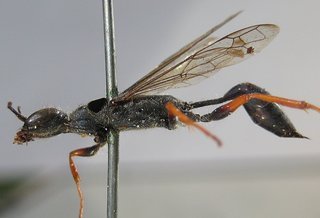
Native Bee Inventory and Monitoring Lab; Photographer: Erika Tucker · 1
Podium rufipes, side |
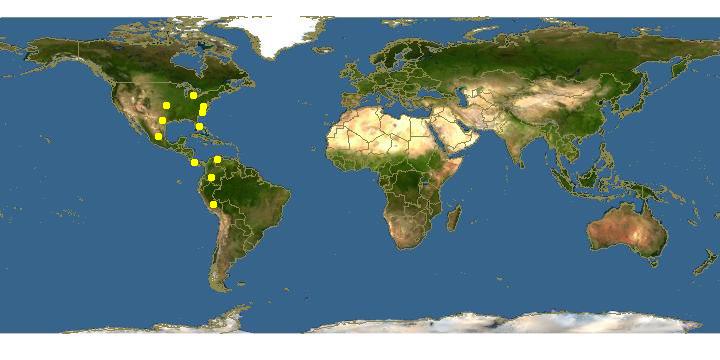
Click on map for details about points.
|
80x5 -
240x3 -
240x4 -
320x1 -
320x2 -
320x3 -
640x1 -
640x2
Set display option above.
Click on
images to enlarge. |
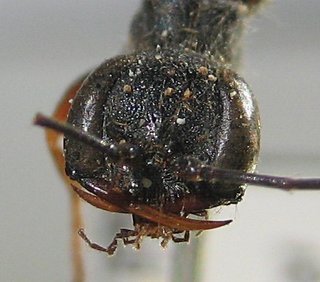
Native Bee Inventory and Monitoring Lab; Photographer: Erika Tucker · 1
Podium rufipes, face |
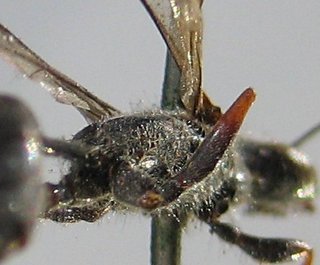
Native Bee Inventory and Monitoring Lab; Photographer: Erika Tucker · 1
Podium rufipes, thorax |
|
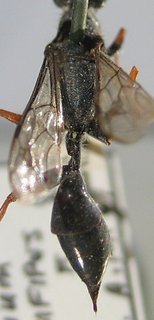
Native Bee Inventory and Monitoring Lab; Photographer: Erika Tucker · 1
Podium rufipes, top |
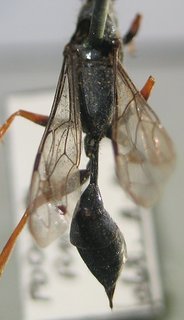
Native Bee Inventory and Monitoring Lab; Photographer: Erika Tucker · 1
Podium rufipes, top |
|
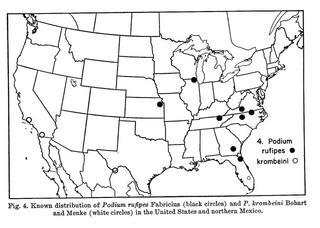
Bohart, R.M., Menke, A.S. 1963 · 0
Podium rufipes, map |
|
Overview |
Taken from:
Bohart, R.M., Menke, A.S. 1963. A Reclassification of the Sphecinae: With a Revision of the Nearctic Species of the Tribes Sceliphronini and Sphecini.
Male.—Average length 19 mm; head, thorax, and abdomen black with bluish reflections; apical three-fourths or less of femora, tibiae, and tarsi reddish; wings clear except for clouding of second submarginal cell; erect hair of head and thorax white; genitalia as in figure 59.
Female.—Average length 19 mm
|
|
|
Names | |
Podium rufipes Fabricius
(Figs. 4,59)
Podium rufipes Fabricius, 1804, Systema Piez., p. 153. Lectotype ♀, Essequibo, British Guiana (COPENHAGEN). Present designation.
Podium denticulatum Smith, 1856, Cat. Hymen. Insects Brit. Mus., 4:236. Syntypes ♂,♀, Brazil (BMNH).
Parapodium biguttatum Taschenberg, 1869, Zeitsehr. Ges. Naturwiss. Hafle, 34:423. Syntypes ♂,♀ ,Venezuela (HALLE).
Podium carolina Rohwer, 1902, Proc. United States Natl. Mus., 40:556. Holotype ♀, Tryon, North Carolina (USNM).
|
|
|
Geographic distribution | |
Distribution.—This species is known from scattered localities in the eastern
United States (Iowa, New York, North Carolina, Kansas, Georgia, Florida), and
its range extends through Central America and South America (fig. 4).
|
|
|
Natural history | |
This species is very similar to krombeini Bohart and Menke except for the differences noted under systematics of that species. The amount of black on the femora
varies. Specimens from Florida have only a little darkening at the base. The syn-
types of rufipes were seen by Bohart and one specimen was labeled as lectotype. We
have not seen the types of denticulatum or biguttatum, and the above synonymy is
tentative only. Schulz (1912) stated that biguttatum was synonymous with rufipes.
Biology—Ran (1937) found Northern American examples of this species using
Sceliphron nests. The original contents were walled off at the back of the cell with
mud, the nest was provisioned with one to three immature cockroaches—Fareoblatta pennylvanica (De Geer) —and the nest was closed with a “clear resin-like gum.” Williams (1928) reported South American rufipes making single-column mud nests on trees and provisioning with wood roaches. Williams also cited one female from Brazil making a nest by closing a hollow in a termite mound with mud.
Krombein (1958e) reared rufipes from trap nests in Florida and North Carolina.
the wasps stored their single-celled nests with four to six roaches, depositing the
egg on the first roach. Blattid prey consisted of: Chorisoneura texensis Saussure
and Zehntner, Cariblatta lutea (Saussnre and Zehntner), Parcoblatta sp., and Ishnoptera sp. Krombein suggested that the wasps may nest in abandoned beetle burrows and natural cavities in dead wood. Two generations occur per year, and Neocrysis panamensis (Cameron) (= Chrysis alabamensis Mocsáry) is an important parasite.
|
|
| Supported by | |
Updated: 2024-04-26 15:16:47 gmt
|